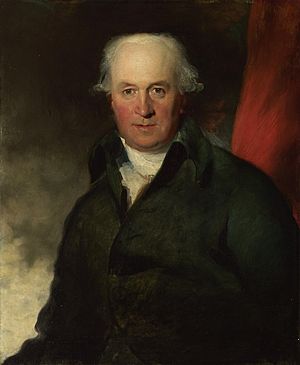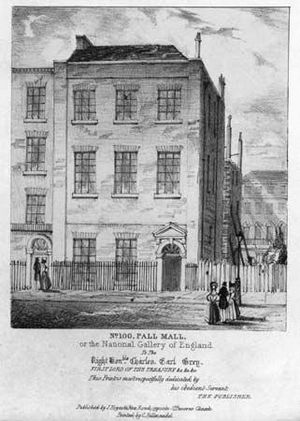John Julius Angerstein facts for kids

John Julius Angerstein (born 1735 – died 1823) was a very important businessman in London. He worked as an insurance underwriter at Lloyd's. He was also a great supporter of the arts and collected many beautiful paintings. When he passed away in 1823, his amazing art collection was almost sold. But King George IV and the Prime Minister, Lord Liverpool, stepped in. They decided to buy his collection for the whole country! This led to the creation of the British National Gallery in 1824. The first paintings were displayed right in Angerstein's own house at 100 Pall Mall.
Early Life and Family
John Julius Angerstein was born in St Petersburg, Russia, in 1735. Some people wrongly thought he was related to Russian empresses, but this was not true. Family stories say his parents were Empress Anna of Russia and a London businessman named Andrew Poulett Thompson. When John Julius was about 15, he moved to London around 1749. His first job was working in Thompson's business office.
In 1771, Angerstein married Anna Crockett. She was a widow and the daughter of Henry Muilman, who was a banker and a consul for Denmark and Russia in London. John and Anna had two children: Juliana and John Angerstein (born 1773). Anna passed away in 1783.
Two years later, in 1785, John Julius Angerstein married Eliza Lucas. She was also a widow. A famous artist named Thomas Lawrence painted a portrait of Angerstein and Eliza in 1792. This painting is now in The Louvre museum in Paris.
A Life of Business and Art

As a merchant, Angerstein was involved in various businesses. He likely insured ships that were part of the slave trade. He also acted as a trustee for some properties, including sugar estates in Grenada, that were connected to debts. However, he also supported the Committee for the Relief of the Black Poor. This group worked to help poor Black people and had strong connections to the movement against slavery.
Angerstein was the chairman of Lloyd's, a famous insurance market, from 1790 to 1796. He was friends with important people like King George III, Prime Minister William Pitt the Younger, and the artist Sir Thomas Lawrence.
He was also known for offering a reward of £100 to catch a criminal known as the "London Monster". This person had attacked women with a knife.

Angerstein was a passionate art collector. He bought artworks by famous painters like Rembrandt, Velázquez, Titian, Raphael, and Hogarth. He also collected early drawings by J. M. W. Turner. From a big art sale in London, he bought a famous painting called The Raising of Lazarus by Sebastiano del Piombo.
After he died, the British government bought 38 of his best paintings for £60,000. These paintings became the very first collection of the British National Gallery. Before the National Gallery building was built in Trafalgar Square, these artworks were shown in Angerstein's house in Pall Mall.
John Julius Angerstein lived for many years in Greenwich, a part of south-east London. In 1774, he leased a large piece of land and built a house called Woodlands. This house was designed by a local architect, George Gibson. The area around his home is now known as Westcombe Park.
Angerstein was also active in other important groups. In 1806, he became vice-president of the new London Institution. A year before that, he helped start the British Institution for Promoting the Fine Arts in the United Kingdom. He was also a regular church-goer at St Alfege's Church, Greenwich, where he served as a churchwarden.
Angerstein's Legacy Today
Angerstein's family connections to Greenwich are still remembered today.
- Angerstein Lane is a street near Blackheath that carries his family name.
- The Angerstein Hotel is a public house on Woolwich Road in Greenwich.
- Close by is the Angerstein Business Park.
- The Angerstein Railway Line is used mainly for freight trains. It links the North Greenwich area to the main railway network.
- Because of this railway line, an industrial area nearby is sometimes called the "Angerstein Triangle."
Images for kids
-
John Julius Angerstein, painted by Thomas Lawrence around 1790.
-
Angerstein's house at 100 Pall Mall, which became the first National Gallery.
-
John Julius Angerstein, painted in 1765 by Joshua Reynolds. He is wearing clothes similar to those in 17th-century paintings.






